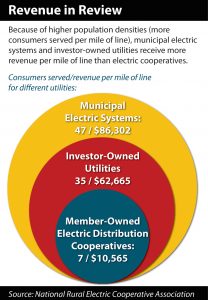
STEVE
SEIBERT
 There are three main types of electricity providers in the U.S. Investor-owned utilities (IOUs) serve primarily densely populated areas, like Evansville and Indianapolis. Municipal-owned utilities also serve densely populated cities from the large such as Richmond to the small like Troy. And, of course, there are rural electric cooperatives like Southern Indiana Power that serve less populated parts of the country.
There are three main types of electricity providers in the U.S. Investor-owned utilities (IOUs) serve primarily densely populated areas, like Evansville and Indianapolis. Municipal-owned utilities also serve densely populated cities from the large such as Richmond to the small like Troy. And, of course, there are rural electric cooperatives like Southern Indiana Power that serve less populated parts of the country.
In the utility business, population matters a lot. Because the costs to serve any given area are similar, with more customers, you can spread the costs among more people to keep rates lower. At least that is the theory.
The graphic at right shows the national averages of density and revenue per mile of electrical line for IOUs, municipal-owned utilities and electric co-ops. Municipal-owned utilities, which operate in cities and towns, have the greatest density — 48.3 customers per mile of line, which generates an average of $113,301 of revenue. IOUs follow with 34 customers per mile of line, while generating average revenues of $75,498. Finally, electric co-ops average 7.4 members (not customers, but members) per mile of line, bringing in an average of $14,938 of revenue per mile.
If I were to give this data to any business school in the country and ask (based on this information) what the rates should be for each of the utilities, the answer would likely be that electric co-ops would have a rate 7.5 times greater than municipal-owned utilities and 5 times higher than IOUs — but that is not the case. Why not?
It has to do with the business model. IOUs are owned by outside investors that may or may not be users of the electric utility they own. These companies’ stocks are traded on Wall Street, and those investors demand a return on their investment. This drives up the price that their customers pay for energy. Many municipal systems charge rates that generate dollars for their cities to help pay for other services.
Southern Indiana Power, however, operates on a not-for-profit basis. Of course, we are a business and must generate enough revenue to cover costs (the largest being the purchase of wholesale power). But we don’t have to charge rates to pay outside stockholders or pay for other services. Because our members are our owners, YOU are our “stockholders.”
This helps us stay focused on our core mission of providing safe, reliable and affordable power while improving the quality of life for our members.
STEVE SEIBERT is president/CEO of Southern Indiana Power.



